1 2 3 4 5 6
Printed in Mexico M08-152697-165052_SCO5RVA_1039339 K1 9/18
USER’S MANUAL
COMBINATION SMOKE &
CARBON MONOXIDE ALARM
IMPORTANT! PLEASE READ CAREFULLY AND SAVE.
This user’s manual contains important information about your Combination Smoke
& Carbon Monoxide Alarm’s operation. If you are installing this Alarm for use by
others, you must leave this manual – or a copy of it – with the end user.
Separate sensors to detect
smoke and CO; the two alarm
systems work independently
Powered by two “AA” batteries
Side access drawer for easy
batter replacement
Certified to ULC Std. S531, UL
Std 217, CSA Std 6.19-06
Printed in Mexico
M08-152697-165052_SCO5RVA_1039339 K1 9/18
Model SCO5RVA
© 2018 BRK Brands, Inc. All rights reserved. Distributed by BRK Brands, Inc. • BRK Brands, Inc. is a
subsidiary of Newell Brands Inc. (NYSE:NWL) • 3901 Liberty Street Road, Aurora, IL 60504-8122 •
Customer Service Team: (800) 323-9005 • www.firstalert.ca • www.brkelectronics.com
All First Alert
®
and BRK
®
Smoke Alarms conform to regulatory
requirements, and are designed to detect particles of combustion. Smoke
particles of varying number and size are produced in all fires.
Ionization technology is generally more sensitive than photoelectric technology at
detecting small particles, which tend to be produced in greater amounts by flaming
fires, which consume combustible materials rapidly and spread quickly. Sources of
these fires may include paper burning in a wastebasket, or a grease fire in the kitchen.
Photoelectric technology is generally more sensitive than ionization technology
at detecting large particles, which tend to be produced in greater amounts
by smoldering fires, which may smolder for hours before bursting into flame.
Sources of these fires may include cigarettes burning in couches or bedding.
For maximum protection, use both types of Smoke Alarms on
each level and in every bedroom of your home.
INTRODUCTION
FIRE SAFETY TIPS
Follow safety rules and prevent hazardous situations: 1) Use smoking materials properly. Never
smoke in bed. 2) Keep matches or lighters away from children; 3) Store flammable materials in
proper containers; 4) Keep electrical appliances in good condition and don’t overload electrical
circuits; 5) Keep stoves, barbecue grills, fireplaces and chimneys grease- and debris-free; 6)
Never leave anything cooking on the stove unattended; 7) Keep portable heaters and open
flames, like candles, away from flammable materials; 8) Don’t let rubbish accumulate.
Keep alarms clean, and test them weekly. Replace alarms immediately if they are not working
properly. Smoke Alarms that do not work cannot alert you to a fire. Keep at least one working
fire extinguisher on every floor, and an additional one in the kitchen. Have fire escape ladders
or other reliable means of escape from an upper floor in case stairs are blocked.
BASIC SAFETY INFORMATION
Da
• Dangers, Warnings, and Cautions alert you to important operating instructions
or to potentially hazardous situations. Pay special attention to these items.
• This combination Smoke/Carbon Monoxide Alarm has two separate alarms. This
CO sensor is designed to detect carbon monoxide gas from any source; it is not
designed to detect any other gases. It will only indicate the presence of carbon
monoxide gas at the sensor. Carbon monoxide gas may be present In other
areas. The Smoke Alarm will only indicate the presence of smoke that reaches
the sensor. The smoke sensor is not designed to sense gas, heat or flames.
• This Smoke/CO Alarm cannot operate without working batteries.
Removing the batteries for any reason, or failing to replace the batteries
at the end of their service life, removes your protection.
• Never Ignore any alarm. See “If Your Smoke/CO Alarm Sounds” for more information
on how to respond to an alarm. Failure to respond can result in Injury or death.
• The Silence Features are for your convenience only and will not correct a problem.
See “Using the Silence Features” for details. Always check your home for a
potential problem after any alarm. Failure to do so can result in Injury or death.
• Test this Smoke/CO Alarm once a week. If the Alarm ever fails to test correctly, have it
replaced immediately! If the Alarm is not working properly, It cannot alert you to a problem.
• This device is designed to protect individuals from the acute effects of carbon monoxide
exposure. It will not fully safeguard individuals with specific medical conditions. If in
doubt consult a medical practitioner. Individuals with medical conditions that may make
them more sensitive to carbon monoxide may consider using warning devices which
provide audible and visual signals for carbon monoxide concentrations under 30 ppm.
INSTALLATION
WHERE TO INSTALL THIS ALARM
This carbon monoxide alarming device is designed to detect carbon monoxide gas from
ANY source of combustion. It is NOT designed to detect smoke, fire, or any other gases.
For minimum security, a combination Smoke/CO Alarm should be centrally located outside of
each separate sleeping area in the immediate vicinity of the bedrooms. For more security, install
additional Alarms in each separate bedroom. The Alarm should be located at least 100 mm (4
inches) from all exterior walls and at least 914 mm (36 inches) from supply or return vents.
For additional protection, Install residential combination Smoke/CO Alarms:
• On every level of your home, including finished attics and basements.
• Inside every bedroom, especially if people sleep with the door partly or completely closed.
• In the hall near every sleeping area. If your home has multiple sleeping areas. install a
unit in each. If a hall is more than 12 meters (40 feet) long, install a unit at each end.
• At the top of first-to-second floor stairway, and at the bottom of the basement stairway.
• For additional coverage, install Alarms in all rooms, halls, and storage areas,
where temperatures normally remain between 4° C and 38° C
• (40º F and 100º F).
RECOMMENDED RESIDENTIAL PLACEMENT
RECOMMENDED PLACEMENT:
Smoke Alarm
One on every level and
in every bedroom
Carbon Monoxide Alarm
One on every level and
in every bedroom
Fire Extinguisher
One on every level, plus
kitchen and garage
HALLWAY BEDROOMBEDROOM
GARAGE
LIVING ROOM KITCHEN
BASEMENT
• When installing on the wall, the top edge of Smoke Alarms should be placed
between 102 mm (4 inches) and 305 mm (12 inches) from the wall/ceiling line.
• When installing on the ceiling, place the alarm as close to the center as possible.
• In either case, install at least 102 mm (4 inches) from where the wall and
ceiling meet. See “Avoiding Dead Air Spaces” for more information.
Note: For any location, make sure no door or other obstruction could
keep carbon monoxide or smoke from reaching the alarm.
WHERE TO INSTALL THIS ALARM IN RECREATIONAL VEHICLES
Install CO Alarms on inside or insulated walls and ceilings ONLY. Uninsulated outside walls and roofs
of RV’s often transfer heat and cold from outdoors. The Alarm should be located at least 152 mm
(6 inches) from all the exterior walls and at least 305 mm (12 inches from supply or return vents).
Test units used in RV’s after the vehicle has been in storage, before each trip, and once a
week while in use. Failure to test units used in RV’s as described may remove your protection.
WHERE THIS ALARM SHOULD NOT BE INSTALLED
DO NOT PLACE THE ALARM:
• In garages, kitchens, furnace rooms, or in any extremely dusty, dirty or greasy areas.
• Within 1.5 meters (5 feet) of any cooking appliance.
• In extremely humid areas. This alarm should be at least 3 meters (10 feet)
from a bath or shower, sauna, humidifier, vaporizer, dishwasher,laundry
room, utility room or other source of high humidity.
• In areas where temperature is colder than 4.4˚ C (40˚ F) or hotter than 37.8˚ C
(100˚ F). These areas include unconditioned crawl spaces, unfinished attics,
uninsulated or poorly insulated ceilings, porches, and garages.
• In turbulent air, like near ceiling fans, heat vents, air conditioners, fresh air returns,
or open windows. Blowing air may prevent CO from reaching the sensors.
• Outside the Mobile Home.
• In direct sunlight.
• In insect infested areas. Insects can clog the openings to the
sensing chamber and cause unwanted alarms.
• Less than 305 mm (12 inches) away from florescent lights.
Electrical “noise” can interfere with the sensor.
• In “dead air” spaces. See “Avoid Dead Air Spaces.”
AVOIDING DEAD AIR SPACES
“Dead air” spaces may prevent smoke from reaching the Smoke/CO Alarm. To
avoid dead air spaces, follow installation recommendations below.
On ceilings, install Smoke/CO Alarms as close to the center of the ceiling as possible. If this is
not possible. install the Smoke/CO Alarm at least 102 mm (4 inches) from the wall or corner
For wall mounting (if allowed by building codes), the top edge of Smoke/
CO Alarms should be placed between 102 mm (4 inches) and 305 mm (12
Inches) from the wall/ceiling line, below typical “dead air” spaces.
On a peaked, gabled, or cathedral ceiling, install first Smoke/CO Alarm within 0.9
meters (3 feet) of the peak of the ceiling, measured horizontally. Additional Smoke/CO
Alarms may be required depending on the length, angle, etc. of the ceiling’s slope.
USING THE SILENCE FEATURES
Never remove the batteries to quiet an unwanted alarm. Removing the
batteries disables the alarm and removes your protection.
The Silence Feature is intended to temporarily silence the horn while you
identify and correct the problem. Do not use the Silence Feature in emergency
situations. It will not correct a CO problem or extinguish a fire.
The Silence Feature can temporarily quiet an unwanted alarm for several minutes. You can silence
this Smoke/CO Alarm: press the Test/Silence button on the alarm cover for at !east 3-5 seconds.
After the Test/Silence button is released, the Red LED blinks during the silence mode.
When the Smoke Alarm is Silenced When the CO Alarm is Silenced
The SmokeAlarm will remain silent for up to
10 minutes, then return to normal operation.
If the smoke has not cleared – or continues to
increase – the device will go back into alarm.
The CO alarm will remain silent
for up to 4 minutes.
After 4 minutes, if CO levels remain potentially
dangerous the horn will start sounding again.
SILENCING THE LOW BATTERY WARNING
This silence feature can temporarily quiet the low battery warning “chirp” for up to 8 hours. You
can silence the low battery warning “chirp’’: press the Test/Silence button on the alarm cover.
Once the low battery warning “chirp” silence feature is activated, the unit continues to flash the
Green light twice a minute for 8 hours. After 8 hours, the low battery “chirp” will resume. Replace
the batteries as soon as possible; this unit will not operate without battery power!
To deactivate this feature: Press the Test/Silence button again. The unit will go into Test Mode
and the low battery warning will resume (LED flashes and unit sounds “chirp” once a minute).
WHAT YOU NEED TO KNOW ABOUT CO
WHAT IS CO?
CO is an invisible, odorless, tasteless gas produced when fossil fuels do not burn completely,
or are exposed to heat (usually fire). Electrical appliances typically do not produce CO.
These fuels Include: Wood, coal, charcoal, oil, natural gas, gasoline, kerosene, and propane.
Common appliances are often sources of CO. If they are not properly maintained,
are improperly ventilated, or malfunction, CO levels can rise quickly. CO Is a real
danger now that homes are more energy efficient. “Air-tight” homes with added
insulation, sealed windows, and other weatherproofing can “trap” CO inside.’
SYMPTOMS OF CO POISONING
These symptoms are related to CO POISONING and should
be discussed with ALL household members.
Mild Exposure: Slight headache, nausea, vomiting, fatigue {‘’flu-like” symptoms).
Medium Exposure: Throbbing headache. drowsiness, confusion, fast heart rate.
Extreme Exposure: Convulsions, unconsciousness, heart and lung failure.
Exposure to Carbon Monoxide can cause brain damage, death.
Da
This CO Alarm measures exposure to CO over time. It alarms if CO levels are extremely high in
a short period of time, or if CO levels reach a certain minimum over a long period of time. The
CO Alarm generally sounds an alarm before the onset of symptoms in average, healthy adults.
Why is this important? Because you need to be warned of a potential CO problem while you
can still react in time. Many cases of reported CARBON MONOXIDE POISONING indicate that
while victims are aware they are not well, they become so disoriented they are unable lo save
themselves by either exiting the building or calling for assistance. Also, young children and
pets may be the first affected. The average healthy adult might not feel any symptoms when
the CO Alarm sounds. However. people with cardiac or respiratory problems, infants, unborn
babies, pregnant mothers, or elderly people can be more quickly and severely affected by CO.
If you experience even mild symptoms of CO poisoning, consult your doctor immediately!
FINDING THE SOURCE OF CO AFTER AN ALARM
Carbon monoxide is an odorless, invisible gas, which often makes it difficult to locate the source of
CO after an alarm. These are a few of the factors that can make it difficult to locate sources of CO:
• House well ventilated before the investigator arrives.
• Problem caused by “backdrafting.”
• Transient CO problem caused by special circumstances.
Because CO may dissipate by the time an investigator arrives, it may be
difficult to locate the source of CO. BRK Brands, Inc. shall not be obligated
to pay for any carbon monoxide investigation or service call.
POTENTIAL SOURCE OF CO IN THE HOME
Fuel-burning appliances
like: portable heater, gas or
wood burning fireplace. gas
kitchen range or cooktop,
gas clothes dryer.
Damaged or insufficient
venting: corroded or
disconnected water heater
vent pipe, leaking chimney
pipe or flue, or cracked
heat exchanger, blocked or
dogged chimney opening.
Improper use of appliance/
device: operating a barbecue grill
or vehicle in an enclosed area (like
a garage or screened porch).
Transient CO Problems:
“transient” or on-again-off-again
CO problems can be caused
by outdoor conditions and
other special circumstances.
The following conditions can result in transient CO situations:
1. Excessive spillage or reverse venting of fuel appliances caused by outdoor conditions such as:
• Wind direction and/or velocity. including high, gusty winds. Heavy air in the
vent pipes (cold/humid air with extended periods between cycles).
• Negative pressure differential resulting from the use of exhaust fans.
• Several appliances running at the same time competing for limited fresh air.
• Vent pipe connections vibrating loose from clothes dryers. furnaces, or waler heaters.
• Obstructions in or unconventional vent pipe designs which can amplify the above situations.
2. Extended operation of unvented fuel burning devices (range, oven, fireplace).
3. Temperature inversions, which can trap exhaust close to the ground.
4. Car idling in an open or closed attached garage, or near a home.
These conditions are dangerous because they can trap exhaust in your home. Since these
conditions can come and go, they are also hard to recreate during a CO investigation.
HOW CAN I PROTECT MY FAMILY
FROM CO POISONING?
A CO Alarm Is an excellent means of protection. It monitors the air and sounds a loud
alarm before Carbon Monoxide levels become threatening for average, healthy adults.
A CO Alarm Is not a substitute for proper maintenance of home appliances.
To help prevent CO problems and reduce the risk of CO poisoning:
• Clean chimneys and flues yearly. Keep them free of debris, leaves, and nests for
proper air flow. Also, have a professional check for rust and corrosion, cracks,
or separations. These conditions can prevent proper air movement and cause
backdrafting. Never “cap” or cover a chimney in any way that would block air flow.
• Test and maintain all fuel-burning equipment annually. Many local gas or oil
companies and HVAC companies offer appliance Inspections for a nominal fee.
• Make regular visual inspections of all fuel-burning appliances. Check appliances for
excessive rust and scaling. Also check the flame on the burner and pilot lights. The
flame should be blue. A yellow flame means fuel is not being burned completely and CO
may be present. Keep the blower door on the furnace closed. Use vents or fans when
they are available on all fuel-burning appliances. Make sure appliances are vented to
the outside. Do not grill or barbecue indoors, or in garages or on screen porches.
• Check for exhaust backflow from CO sources. Check the draft hood on an operating
furnace for a backdraft. Look for cracks on furnace heat exchangers.
• Check the house or garage on the other side of shared wall.
• Keep windows and doors open slightly. If you suspect that CO is escaping into your home,
open a window or a door. Opening windows and doors can significantly decrease CO levels.
In addition, familiarize yourself with all enclosed materials. Read this manual in its
entirety, and make sure you understand what to do if your CO Alarm sounds.
REGULATORY INFORMATION FOR SMOKE/CO ALARMS
REGULATORY INFORMATION FOR CO ALARMS
WHAT LEVELS OF CO CAUSE AN ALARM?
Canadian Standard 6.19 requires residential CO Alarms to sound when
exposed to levels of CO and exposure times as described below. They are
measured in parts per million (ppm) of CO over time (in minutes).
CSA 6.19 Required Alarm Points*:
• If the alarm is exposed to 400 ppm of CO, it must alarm between 4 and 15 minutes
• If the alarm is exposed to 150 ppm of CO, it must alarm between 10 and 50 minutes.
• If the alarm is exposed to 70 ppm of CO, it must alarm between 60 and 240 minutes.
* Approximately 10% COHb exposure at levels of 10% to 95% Relative Humidity (RH).
The unit is designed not to alarm when exposed to a constant level of 30 ppm for 30 days.
Da
CO Alarms are designed to alarm before there is an immediate life threat.
Since you cannot see or smell CO, never assume it’s not present.
This is only possible if Alarms are located, installed, and maintained as described in this manual.
Gas Detection at Typical Temperature and Humidity Ranges: The CO Alarm is not formulated
to detect CO levels below 30 ppm typically. Tested for false alarm resistance to Methane (500 ppm),
Butane (300 ppm), Heptane (500 ppm), Ethyl Acetate (200 ppm), Isopropyl Alcohol (200 ppm) and
Carbon Dioxide (5000 ppm). Values measure gas and vapor concentrations in parts per million.
Audible Alarm: 85 dB minimum at 3 meters (10 feet).
WHERE CO ALARMS SHOULD NOT BE INSTALLED IN
RECREATIONAL VEHICLES
DO NOT LOCATE THIS SMOKE/CO ALARM:
• Outside the RV.
• Within 1.5 meters (5 feet) of any cooking appliance.
• In extremely humid areas. Avoid installing in close proximity to
a bath or shower or other source of high humidity.
• In locations where the temperatures are regularly below -40˚ C (-40˚F) or above 66˚ C (150˚ F).
• In turbulent air, like near ceiling fans, heat vents, air conditioners, fresh air returns,
or open windows. Blowing air may prevent CO from reaching the sensors.
HOW TO INSTALL THIS ALARM
Da
This combination Smoke/CO Alarm was designed to be mounted on the ceiling or
wall. It is not a tabletop device. You must install this device on the ceiling or wall
as outlined below. Read “Where To Install This Alarm” before starting.
PARTS OF THIS SMOKE/CO ALARM
1. Test/Silence Button
2. Battery Compartment
3. Power/Smoke Alarm LED
4. CO Alarm LED
Tools you will need: pencil,
drill with 5mm or 3/16” drill bit,
flathead screwdriver, hammer.
• Do not connect this unit to any other alarm or auxiliary device. It is a
single-station unit that cannot be linked to other devices. Connecting
anything else to this unit may prevent it from working properly.
• Do not install this unit over an electrical junction box. Air currents around junction
boxes can prevent smoke from reaching the sensing chamber and prevent the unit from
alarming. Only AC powered units are intended for installation over junction boxes.
Da
If you want to lock the battery compartment, or lock the Smoke/CO Alarm to the
mounting bracket, please read the “Optional Locking Features” section.
1. Hold base firmly and twist the mounting bracket
counterclockwise (left) to separate it from the unit.
2. Hold the mounting bracket against the ceiling (or wall) so the vertical
mounting slot is aligned in the 12 o’clock position and trace around the
inside of the mounting slots (vertical and horizontal mounting).
3. Put the unit where it won’t get covered with dust when you drill the mounting holes.
4. Using a 5 mm (3/16”) drill bit, drill a hole through the center of the oval outlines you traced.
5. Insert the plastic screw anchors (in the plastic bag with screws) into the holes. Tap the screw
anchors gently with a hammer, if necessary, until they are flush with the ceiling or wall.
6. Line the mounting bracket up over the plastic screw anchors
7. Screw the mounting bracket to the ceiling or wall through the
mounting slots using the two screw provided
8. Before attaching the Alarm to
the bracket, insert the two (2)
AA batteries (included) into the
battery compartment. Match
the terminals on the end of
the battery with the terminals
on the unit. Match “+” to “+”
and “-” to “-”. If the batteries
are not fully inserted, the unit
cannot receive battery power.
Note: The unit may beep briefly when you install the batteries. This is normal. The GREEN
Light flashes about every 60 seconds when the unit is receiving battery power.
The battery door will resist closing unless batteries are installed.
This warns you the unit will not operate without batteries.
9. Attach the Smoke/CO Alarm to the mounting bracket.
Line up the guides on the alarm’s base with the guides
on the mounting bracket. When guides are lined up,
turn the base clockwise (right) until it snaps into place.
Note: Once the Smoke/CO Alarm is snapped
onto the mounting bracket, you can rotate the
Smoke/CO Alarm to adjust the alignment.
10. Test the Smoke/CO Alarm. See
“Weekly Testing” for details.
REGULAR MAINTENANCE
This unit has been designed to be as maintenance-free as possible but there
are a few simple things you must do to keep it working properly.
• Test it at least once a week by pressing the test button of the Smoke/
Heat or CO Alarm with which it is interconnected.
• Clean the Smoke/CO Alarm at least once a month; gently vacuum the outside
of the Smoke/CO Alarm using your household vacuum’s soft brush
• allachment. A can of clean compressed air (sold at computer or office supply stores)
may also be used. Follow manufacturer instructions for use. Test the Smoke/CO
Alarm. Never use water, cleaners or solvents since they may damage the unit.
• If the Smoke/CO Alarm becomes contaminated by excessive dirt, dust and/
or grime, and cannot be cleaned lo avoid unwanted alarms, replace
• the unit immediately.
• Relocate the unit if it sounds frequent unwanted alarms. See
·’Where This Alarm Should Not Be Installed” for details.
CHOOSING A REPLACEMENT BATTERY:
Your Smoke/CO Alarm requires two standard AA batteries. It was shipped with
two AA batteries. The following batteries are acceptable as replacements:
Duracell MN1500. These batteries are available at many local retail stores.
Always use the exact batteries specified by this User’s Manual. DO NOT use
rechargeable batteries. Clean the battery contacts and also those of the device prior
to battery installation. Install batteries correctly with regard to polarity (+ and -).
Please dispose of or recycle used batteries properly, following any local regulations. Consult your
local waste management authority or recycling organization to find an electronics recycling facility
in your area. DO NOT DISPOSE OF BATTERIES IN FIRE. BATTERIES MAY EXPLODE OR LEAK.
WEEKLY TESTING
• NEVER use an open flame of any kind to test this unit. You might accidentally
damage or set fire to the unit or to your home. NEVER use vehicle exhaust!
Exhaust may cause permanent damage and voids your warranty.
• DO NOT stand close to the Alarm when the horn is sounding. Exposure at close range
may be harmful to your hearing. When testing, step away when horn starts sounding.
It is important to test this unit every week to make sure it is working properly.
Using the test button Is the recommended way to test this Smoke/CO Alarm.
Test the Smoke/CO Alarm: press and hold the Test/Silence
button 3-5 seconds until unit starts to alarm.
During testing, you will see and hear the following sequence:
• The Horn will sound 3 beeps, pause, 3 beeps. The Power/
Smoke LED flashes Red and the CO LED will be Off.
NOTE: For Canada, the Horn will sound 3 beeps, pause, 3 beeps. The
Power/Smoke LED flashes Red and the CO LED will be Off.
• Next the Horn will sound 4 beeps, pause, 4 beeps. The Power/
Smoke LED will be Off and the CO LED flashes Red.
If the unit does not alarm, make sure the batteries are correctly installed,
and test again. If the unit still does not alarm, replace it immediately.
Keep battery out of reach of children. In the event a battery is swallowed,
immediately contact your poison control center, your physician, or the National
Battery Ingestion hotline at 416-813-5900 as serious injury may occur.
Da
Actual battery service life depends on the Smoke/CO Alarm and the environment in which
it is Installed. All the batteries specified above are acceptable replacement batteries for
this unit. Regardless of the manufacturer’s suggested battery life, you MUST replace
the battery immediately once the unit starts “chirping” (the “low battery warning”).
To replace the batteries (without removing
Alarm from the ceiling or wall):
1. Open the battery compartment.
2. Press tabs A and B as shown in the diagram
and remove each battery.
3. Insert the new batteries. making sure they snap completely
into the battery compartment. Match the terminals on the
ends of the batteries with the terminals on the unit.
4. Close the battery compartment, and then test the
unit by pressing the Test/Silence button.
A
B
IF YOUR SMOKE/CO ALARM SOUNDS
WHAT TO DO FIRST – IDENTIFY THE TYPE OF ALARM
Type of Alarm What You See and Hear
Carbon Monoxide (CO)
CO LED: Flashes Red
Horn: 4 beeps, pause, 4 beeps, pause
Power/Smoke LED: Off
Smoke
Power/Smoke LED: Flashes Red
Horn: 3 beeps, pause, 3 beeps, pause
For Canada:
Horn: 3 beeps, pause, 3 beeps, pause
CO LED: Off
IF THE CO ALARM SOUNDS
Actuation of your CO Alarm indicates the presence of carbon monoxide (CO) which
can kill you. In other words, when your CO Alarm sounds, you must not ignore it!
1. Immediately move to fresh air – outdoors or by an open door or window. Do a head count
to check that all persons are accounted for. Do not re-enter the premises,or move away
from the open door or window until the emergency services responder has arrived, the
premises have been aired out, and your CO Alarm remains in its normal condition.
2. Call your emergency services, fire department or 911. Write down
the number of your local emergency service here:
___________________________________________________________________
“ALARM-MOVE TO FRESH AIR”
If you hear the CO alarm horn and the CO red light is flashing, move
everyone to a source of fresh air. DO NOT remove the batteries!
IF THE SMOKE ALARM SOUNDS
RESPONDING TO AN ALARM
• If the unit alarms and you are not testing the unit, it is warning you of a
potentially dangerous situation that requires your immediate attention. NEVER
ignore any alarm. Ignoring the alarm may result in injury or death.
• Never remove the batteries from a battery operated Smoke/CO Alarm to stop an
unwanted alarm (caused by cooking smoke, etc.). Removing batteries disables
the alarm so it cannot sense smoke, and removes your protection. Instead open a
window or fan the smoke away from the unit. The alarm will reset automatically.
• If the unit alarms get everyone out of the house immediately.
WHAT TO DO IN CASE OF FIRE
• Don’t panic; stay calm. Follow your family escape plan.
• Get out of the house as quickly as possible. Don’t stop to get dressed or collect anything.
• Feel doors with the back of your hand before opening them. If a door is cool, open it slowly.
Don’t open a hot door. Keep doors and windows closed, unless you must escape through them.
• Cover your nose and mouth with a cloth (preferably damp). Take short, shallow breaths.
• Meet at your planned meeting place outside your home, and do a
head count to make sure everybody got out safely.
• Call the Fire Department as soon as possible from outside. Give your address, then your name.
• Never go back inside a burning building for any reason.
• Contact your Fire Department for ideas on making your home safer.
Alarms have various limitations. See “General Limitations of Smoke/CO Alarms” for details.
RECOMMENDED LOCATIONS FOR SMOKE ALARMS
Installing Smoke Alarms in Single-Family Residences
The National Fire Protection Association (NFPA), recommends one Smoke Alarm on every floor, in
every sleeping area, and in every bedroom. In new construction, the Smoke Alarms must be AC
powered and interconnected. See “Agency Placement Recommendations” for details. For additional
coverage, it is recommended that you install a Smoke Alarm in all rooms, halls, storage areas, finished
attics, and basements, where temperatures normally remain between 40º F (4.4º C) and 100º F (37.8º
C). Make sure no door or other obstruction could keep smoke from reaching the Smoke Alarms.
More specifically, install Smoke Alarms:
• On every level of your home, including finished attics and basements.
• Inside every bedroom, especially if people sleep with doors closed.
• In the hall near ever sleeping area. If your home has multiple sleeping areas, install a
unit in each. If a hall is over 40 feet (12 meters) long, install an alarm at each end.
• At the top of the first-to-second floor stairway, and at the bottom of basement stairway.
Da
Specific requirements for Smoke Alarm installation vary from state to state and from region
to region. Check with your local Fire Department for current requirements in your area. It
is recommended AC or AC/DC units be interconnected for added protection.
RECOMMENDED PLACEMENT:
Smoke Alarm
One on every level and
in every bedroom
Carbon Monoxide Alarm
One on every level and
in every bedroom
Fire Extinguisher
One on every level, plus
kitchen and garage
HALLWAY BEDROOMBEDROOM
GARAGE
LIVING ROOM KITCHEN
BASEMENT
AGENCY PLACEMENT RECOMMENDATIONS
NFPA 72 CHAPTER 29
“For your information, the National Fire Alarm and Signaling Code. NFPA 72, reads as follows:”
29.5.1* Required Detection.
29.5.1.1* Where required by other governing laws, codes, or standards for a specific type of
occupancy, approved single and multiple-station smoke alarms shall be installed as follows:
(1) * in all sleeping rooms and guest rooms
(2) * Outside of each separate dwelling unit sleeping area. within 21 ft (6.4 m) of any
door to a sleeping room, with the distance measured along a path of travel
(3) On every level of a dwelling unit, including basements
(4) On every level of a residential board and care occupancy (small facility),
including basements and excluding crawl spaces and unfinished attics
(5) * In the living area(s) of a guest suite
(6) In the living area(s) of a residential board and care occupancy (small facility)
(Reprinted with permission from NFPA 72
®
. National Fire Alarm and Signaling Code Copyright © 2010
National Fire Protection Association, Quincy, MA 02269. This reprinted material is not the complete
and official position of the National Fire Protection Association, on the referenced subject which is
represented only by the standard in its entirety), (National Fire Alarm and Signaling Code
®
and NFPA
72
®
are registered trademarks of the National Fire Protection Association. Inc., Quincy, MA 02269).
Alarms in the living rooms, dining rooms, bedrooms, kitchens, hallways, finished attics.
furnace rooms, closets. utility and storage rooms, basements, and attached garages.
ABOUT SMOKE ALARMS
Battery (DC) operated Smoke Alarms: Provide protection even when
electricity fails, provided the batteries are fresh and correctly installed. Units
are easy to install, and do not require professional installation.
AC powered Smoke Alarms: Can be interconnected so if one unit senses
smoke, all units alarm. They do not operate if electricity fails.
AC with battery (DC) back-up: will operate if electricity fails, provided the batteries are fresh
and correctly installed. AC and AC/DC units must be installed by a qualified electrician.
Smoke/CO Alarms for Solar or Wind Energy users and battery backup power systems:
AC powered Smoke/CO Alarms should only be operated with true or pure sine wave
inverters. Operating this Alarm with most battery powered UPS (uninterruptible power supply)
products or square wave or “quasi sine wave” inverters will damage the Alarm. If you are not
sure about your inverter or UPS type, please consult with the manufacturer to verify.
ABOUT SMOKE ALARMS (CONTINUED)...
Smoke Alarms for the hearing impaired: Special purpose Smoke Alarms should
be installed for the hearing impaired. They include a visual alarm and an audible
alarm horn, and meet the requirements of the Americans With Disabilities Act.
Can be interconnected so if one unit senses smoke, all units alarm.
Smoke Alarms are not to be used with detector guards unless the
combination has been evaluated and found suitable for that purpose.
All these Smoke Alarms are designed to provide early warning of fires if located, installed
and cared for as described in the user’s manual, and if smoke reaches the Alarm.
SPECIAL COMPLIANCE CONSIDERATIONS
This unit alone is not a suitable substitute for complete fire detection systems in
places housing many people-like apartment buildings, condominiums, hotels, motels,
dormitories, hospitals, long-term health care facilities, nursing homes, day care
facilities, or group homes of any kind-even if they were once single-family homes. It is
not a suitable substitute for complete fire detection systems In warehouses, Industrial
facilities, commercial buildings, and special-purpose non-residential buildings which
require special fire detection and alarm systems. Depending on the building codes in
your area, this unit may be used to provide additional protection in these facilities.
In new construction, most building codes require the use AC or AC/DC
powered Smoke Alarms only. AC, AC/DC, or DC powered Smoke Alarms can
be used in existing construction as specified by local building codes.
In Canada, refer to the Canadian National Building Code of Canada, the National
Fire Code of Canada, CAN/ULC S553 and local requirements.
GENERAL LIMITATIONS OF SMOKE/CO ALARMS
Smoke/CO Alarms may not waken all individuals. Practice the escape plan at least twice a
year, making sure that everyone is involved - from kids to grandparents. Allow children to master
fire escape planning and practice before holding a fire drill at night when they are sleeping. If
children or others do not readily waken to the sound of the Smoke/CO Alarm, or if there are infants
or family members with mobility limitations, make sure that someone is assigned to assist them in
fire drill and in the event of an emergency. It is recommended that you hold a fire drill while family
members are sleeping in order to determine their response to the sound of the Smoke/CO Alarm
while sleeping and to determine whether they may need assistance in the event of an emergency.
Smoke/CO Alarms cannot work without power. Battery operated units cannot work if the batteries
are missing. disconnected or dead, if the wrong type of batteries are used, or if the batteries are not
installed correctly. AC units cannot work if the AC power is cut off for any reason (open fuse or circuit
breaker, failure along a power line or at a power station, electrical fire that burns the electrical wires,
etc.). If you are concerned about the limitations of battery or AC power, install both types of units.
This Smoke/CO Alarm will not sense smoke or CO that does not reach the sensors. It will
only sense smoke or CO at the sensor. Smoke or CO may be present in other areas. Doors or other
obstructions may affect the rate at which CO or smoke reaches the sensors. If bedroom doors are
usually closed at night, we recommend you install an alarm device (Combination CO and Smoke
Alarm, or separate CO Alarms and Smoke Alarms) in each bedroom and in the hallway between them.
This Smoke/CO Alarm may not sense smoke or CO on another level of the home. Example:
This alarm device, installed on the second floor, may not sense smoke or CO in the basement.
For this reason, one alarm device may not give adequate early warning. Recommended minimum
protection is one alarm device in every sleeping area, every bedroom, and on every level of your
home. Some experts recommend battery powered Smoke and CO Alarms be used in conjunction
with interconnected AC powered Smoke Alarms. For details, see “About Smoke Alarms” for details.
Smoke/CO Alarms may not be heard. The alarm horn loudness meets or exceeds current
standards of 85 dB at 3 meters (10 feet). However, if the Smoke/CO Alarm is installed
outside the bedroom, it may not wake up a sound sleeper or one who has recently used
drugs or has been drinking alcoholic beverages. This is especially true if the door is closed
or only partly open. Even persons who are awake may not hear the alarm horn if the sound
is blocked by distance or closed doors. Noise from traffic, stereo, radio, television, air
conditioner. or other appliances may also prevent alert persons from hearing the alarm
horn. This Smoke/CO Alarm is not intended for people who are hearing impaired.
The Alarm may not have time to alarm before the fire itself causes damage,
injury, or death, since smoke from some fires may not reach the unit immediately.
Examples of this include persons smoking in bed, children playing with matches,
or fires caused by violent explosions resulting from escaping gas.
This Smoke/CO Alarm is not a substitute for life insurance. Though this Smoke/CO Alarm
warns against increasing CO levels or the presence of smoke, BRK Brands, Inc. does not warrant or
imply in any way that they will protect lives. Homeowners and renters must still insure their lives.
This Smoke/CO Alarm has a limited life. Although this Smoke/CO Alarm and all of its
parts have passed many stringent tests and are designed to be as reliable as possible,
any of these parts could fail at any time. Therefore. you must test this device weekly. Any
Smoke/CO Alarm that is beyond the replacement date should be replaced immediately.
This Smoke/CO Alarm is not foolproof. Like all other electronic devices, this Smoke/CO Alarm
has limitations. It can only detect smoke or CO that reaches the sensors. It may not give early
warning of the source of smoke or CO is in a remote part of the home, away from the alarm device.
Constant exposure to high or tow humidity may reduce battery life.
TROUBLESHOOTING GUIDE
IF THE ALARM... PROBLEM... YOU SHOULD...
Horn “chirps” about once per minute. Low battery warning. Install two new AA batteries*.
Horn does three rapid “chirps” every minute Device is not working properly, and needs to be replaced.
Units under warranty should be returned to manufacturer
for replacement. See “Limited Warranty” for details.
Carbon Monoxide Alarm Only:
CO Alarm goes back into alarm 4 minutes after you Silence it. CO levels indicate a potentially dangerous situations.
IF YOU ARE FEELING SYMPTOMS OF CO POISONING,
EVACUATE your home and call 911 or the Fire Department.
Refer to “If The CO Alarm Sounds” for details.
CO Alarm sounds frequently even though no high
levels of CO are revealed in an investigation.
The CO Alarm may be improperly located. Refer
to “Where to Install This Alarm for details.
Relocate your Alarm. If frequent alarms continue, have
home rechecked for potential CO problems. You may
be experiencing an intermittent CO problem.
Smoke Alarm Only:
Smoke Alarm sounds when no smoke is visible.
Unwanted alarm may be caused by non-
emergence source like cooking smoke.
Silence Alarm using manual button; clean the alarm’s
cover with a soft, clean cloth. If frequent unwanted alarms
continue, relocate your Alarm. Alarm may be too close to
a kitchen, cooking appliance, or steamy bathroom.
*For a list of acceptable replacement batteries, see “Regular Maintenance.”
If you have any questions that cannot be answered by reading this manual, call Customer Service Team: 1-800-323-9005.
LIMITED WARRANTY
BRK Brands, Inc., (“BRK”) the maker of First Alert
®
brand and BRK
®
brand products, warrants that for a period of ten years from the date of purchase, this product will be free from defects in material
and workmanship. BRK, at its option, will repair or replace this product or any component of the product found to be defective during the warranty period. Replacement will be made with a new
or remanufactured product or component. If the product is no longer available, replacement may be made with a similar product of equal or greater value. This is your exclusive warranty.
This warranty is valid for the original retail purchaser from the date of initial retail purchase and is not transferable. Keep the original sales receipt. Proof of purchase is required to obtain warranty
performance. BRK dealers, service centers, or retail stores selling BRK products do not have the right to alter, modify or any way change the terms and conditions of this warranty.
This warranty does not cover normal wear of parts or damage resulting from any of the following: negligent use or misuse of the product, use on improper
voltage or current, use contrary to the operating instructions, disassembly, repair or alteration by anyone other than BRK or an authorized service center. Further,
the warranty does not cover Acts of God, such as fire, flood, hurricanes and tornadoes or any batteries that are included with this unit.
BRK shall not be liable for any incidental or consequential damages caused by the breach of any express or implied warranty. Except to the extent prohibited by applicable law,
any implied warranty of merchantability or fitness for a particular purpose is limited in duration to the duration of the above warranty. Some states, provinces or jurisdictions
do not allow the exclusion or limitation of incidental or consequential damages or limitations on how long an implied warranty lasts, so the above limitations or exclusion
may not apply to you. This warranty gives you specific legal rights, and you may also have other rights that vary from state to state or province to province.
How to Obtain Warranty Service
Service: If service is required, do not return the product to your retailer. In order to obtain warranty service, contact the Customer Service Team at
1-800-323-9005. To assist us in serving you, please have the model number and date of purchase available when calling.
For Warranty Service return to: 1301 Joe Battle, El Paso, TX 79936
Battery: BRK Brands, Inc. make no warranty, express or implied, written or oral, including that of merchantability or fitness for any particular purpose with respect to battery.
Visit www.firstalert.ca for more information.
For your records, please record:
Date Purchased: _______________________________
Where Purchased: ____________________________________________
Replace Alarm 84 months after installation.
Note: End of Life Signal – Once the unit reaches the end of its lifecycle, the malfunction signal
will sounds once a minute to indicate the need to immediately replace the Alarm.
The End-of-Life Signal can be
silenced for up to 2 days.
Do not unplug the alarm or remove the
batteries until you get replacement.
The replacement date is the date
beyond which the device may no
longer detect carbon monoxide and
should be immediately replaced.
OPTIONAL LOCKING FEATURES
The optional locking features are designed to discourage unauthorized removal of the batteries or Alarm. It is not necessary
to activate the locks in single-family households where unauthorized battery or Alarm removal is not a concern.
This Smoke/CO Alarm has two separate locking features: one to lock the battery compartment. and the other to lock the Smoke/
CO Alarm to the mounting bracket. You can choose to use either feature independently, or use them both.
Tools you will need:
•
Needle-nose pliers
•
Standard flathead screwdriver
Both locking features use locking pins, which are molded into the mounting bracket. Depending on which locking
features you use, remove one or both pins from the mounting bracket using needle-nose pliers.
Da
To permanently remove either locking pin, insert a flathead screwdriver between the locking pin and the lock and pry the pin out of the lock.
TO LOCK THE BATTERY COMPARTMENT
Do not lock the battery compartment until you install
the batteries and test the Smoke/CO Alarm.
1. Install the batteries before attaching the Alarm to the bracket. Insert
two (2) AA batteries (included) into the battery compartment. Match the
terminals on the end of the battery with the terminals on the unit. Match
“+” to “+” and “-”
to “-”. If the batteries are not fully inserted, the
unit cannot receive battery power.
2. Push and hold Test/Silence button until the alarm sounds.
Da
If the unit does not alarm during testing, DO NOT lock the
battery compartment! Install new batteries and test again.
If the unit still does not alarm, replace it immediately.
3. Using needle-nose pliers, detach one locking
pin from the mounting bracket.
4. Push the locking pin through the hole near the battery
door latch on the back of the Smoke/CO Alarm.
TO LOCK THE MOUNTING BRACKET
1. Using needle-nose pliers, detach one
locking pin from the mounting bracket.
2. Insert the locking pin through the
hole on the back of the Smoke/CO
Alarm as shown in the diagram.
3. When you attach the Smoke/CO
Alarm to the mounting bracket,
the locking pin’s head will fit
into a notch on the bracket.
TO UNLOCK THE BATTERY COMPARTMENT
1. Remove the Smoke/CO Alarm from the mounting
bracket. If the unit is locked to the bracket, see
the section “To Unlock the Mounting Bracket.”
2. Insert a flathead screwdriver under the head
of the locking pin, and gently pry it out of the
battery compartment lock. (If you plan to relock
the battery compartment, save the locking pin.)
3. To relock the battery compartment, close the
battery door and reinsert locking pin in lock.
4. Reattach the Smoke/CO Alarm to the mounting
bracket.
Da
When replacing the batteries, always
test the Smoke/CO Alarm before
relocking the battery compartment.
TO UNLOCK THE MOUNTING BRACKET
1. Insert a flathead screwdriver into the
rectangular cut-out on the mounting
bracket nearest to the locking pin.
2. Pry the Smoke/CO Alarm away from the
bracket by pushing up on the screwdriver
and turning the Smoke/CO Alarm
counterclockwise (left) at the same time.
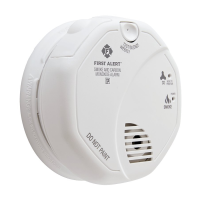
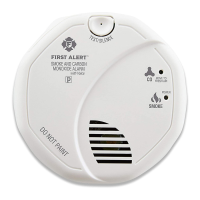
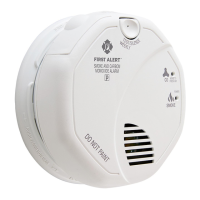
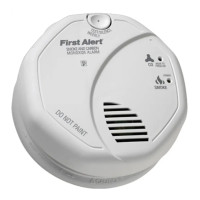
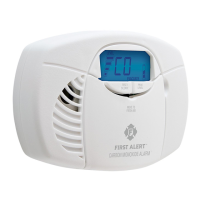
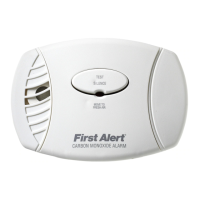
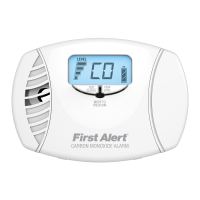
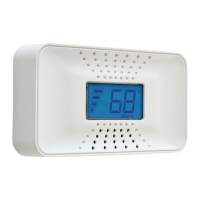
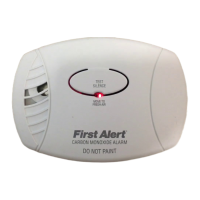

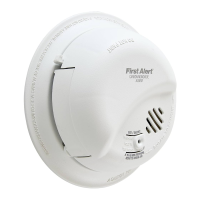
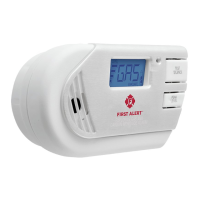
